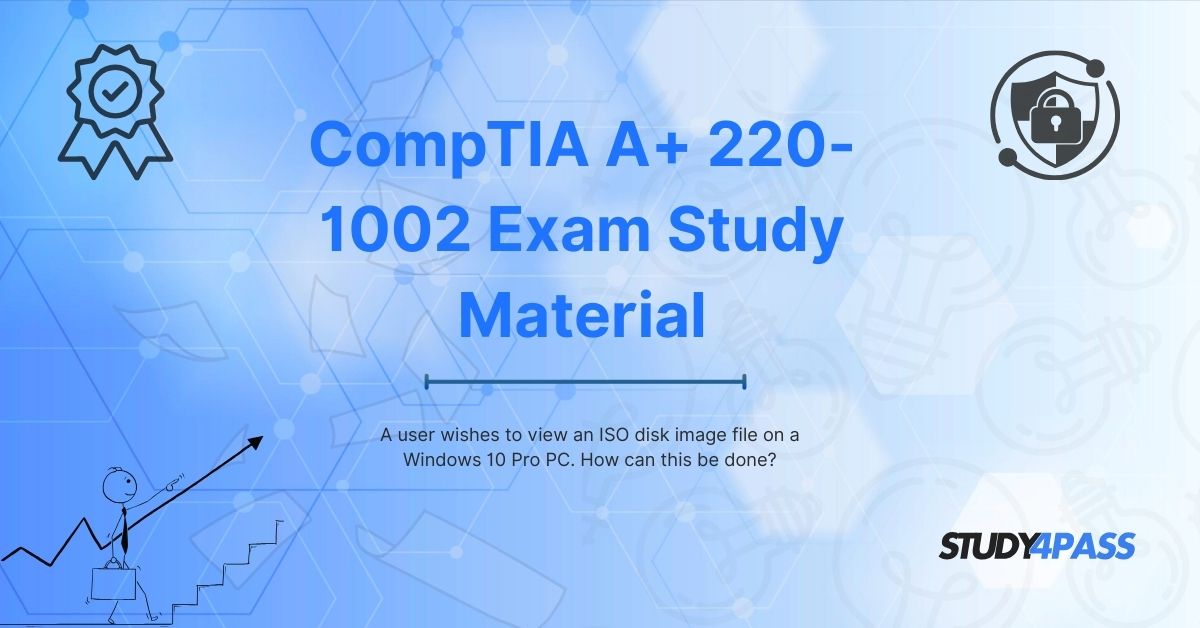Introduction
An ISO file is a disk image that contains an exact copy of a CD, DVD, or Blu-ray disc. These files are commonly used for software distribution, operating system installations, and backups. Windows 10 Pro provides built-in tools to mount and view ISO files without requiring third-party software.
In this guide, we will explore multiple methods to open and view ISO disk image files on a Windows 10 Pro PC. This topic is particularly relevant for those preparing for the CompTIA A+ 220-1002 exam, as understanding disk management and file systems is crucial for certification.
For additional study resources, consider visiting Study4Pass, a reliable platform offering high-quality CompTIA A+ study materials, practice exams, and expert guidance to help you pass your certification exams with confidence.
Method 1: Mounting an ISO File Using File Explorer
Windows 10 Pro includes native support for mounting ISO files as virtual drives. Here’s how to do it:
Step-by-Step Guide
- Locate the ISO File
- Navigate to the folder where the ISO file is stored.
- Right-click the ISO file and select Mount from the context menu.
- Alternatively, double-click the ISO file to mount it automatically.
- Open File Explorer and check under This PC.
- A new virtual drive will appear, labeled with the ISO file’s name.
- Double-click the virtual drive to explore its contents, just like a physical CD/DVD.
- When done, right-click the virtual drive and select Eject to unmount the ISO.
Advantages of This Method
- No additional software required
- Quick and easy mounting process
- Integrated into Windows 10 Pro
Method 2: Extracting ISO Files Using File Archivers
If you prefer not to mount the ISO, you can extract its contents using tools like 7-Zip, WinRAR, or PeaZip.
Step-by-Step Guide
- Install a File Archiver
- Download and install 7-Zip (free) or WinRAR (trial).
- Right-click the ISO file.
- Select 7-Zip > Extract Here (or equivalent option).
- The contents will be extracted to a folder in the same directory.
Advantages of This Method
- No need to mount the ISO
- Useful for copying specific files
- Works on all Windows versions
Method 3: Burning ISO to a Physical Disc
If you need the ISO on a physical disc (DVD/USB), Windows 10 Pro allows burning ISO files directly.
Step-by-Step Guide
- Insert a Blank Disc
- Ensure the disc has enough capacity for the ISO.
- Select Burn disc image.
- Choose the correct disc burner and click Burn.
Advantages of This Method
- Creates a bootable disc if needed
- Useful for OS installations
- Permanent storage solution
Method 4: Using Third-Party Virtual Drive Software
For advanced users, third-party tools like Daemon Tools, PowerISO, or Virtual CloneDrive offer additional features.
Step-by-Step Guide
- Download and Install Software
- Install a virtual drive manager like Daemon Tools Lite.
- Open the software, click Mount, and select the ISO file.
- The ISO will appear as a new drive in File Explorer.
Advantages of This Method
- Supports multiple virtual drives
- Advanced features like ISO creation
- Useful for legacy systems
CompTIA A+ 220-1002 Exam Relevance
Understanding ISO files and disk management is crucial for the CompTIA A+ 220-1002 exam. Key topics include:
- Disk Management Tools (Diskpart, Formatting)
- File Systems (NTFS, FAT32, exFAT)
- Virtualization & Storage (ISO, VHD)
For in-depth study materials, visit Study4Pass, which offers CompTIA A+ practice tests, flashcards, and video tutorials to help you master these concepts.
Conclusion
Windows 10 Pro provides multiple ways to view ISO disk image files, whether by mounting, extracting, burning, or using third-party tools. Mastering these methods is essential for IT professionals and CompTIA A+ candidates.
For the best CompTIA A+ 220-1002 exam preparation, check out Study4Pass, a trusted resource for certification success.
Special Discount: Offer Valid For Limited Time “220-1002 Exam Material”
Actual Exam Questions For CompTIA's 220-1002 Certification
Sample Questions For CompTIA 220-1002 Practice Exam
1. How can a user mount an ISO disk image file in Windows 10 Pro without third-party software?
a) By renaming the file extension to .ZIP and extracting it
b) By right-clicking the ISO file and selecting "Mount"
c) By opening it with Notepad
d) By burning it to a CD/DVD first
2. Which built-in Windows 10 Pro feature allows users to access the contents of an ISO file as a virtual drive?
a) Disk Cleanup
b) File Explorer
c) Windows Defender
d) Task Manager
3. What happens when an ISO file is mounted in Windows 10 Pro?
a) The ISO file is deleted from the system
b) The ISO file is extracted to a temporary folder
c) The ISO file appears as a separate drive in "This PC"
d) The ISO file is automatically burned to a USB drive
4. Which of the following is NOT a method to view the contents of an ISO file in Windows 10 Pro?
a) Using third-party software like WinRAR or 7-Zip
b) Burning the ISO to a DVD
c) Opening it with Microsoft Word
d) Mounting it via File Explorer
5. After mounting an ISO file in Windows 10 Pro, how can the user safely remove (unmount) it?
a) By deleting the ISO file
b) By right-clicking the virtual drive in "This PC" and selecting "Eject"
c) By restarting the computer
d) By formatting the virtual drive


